↧
Leftover Mass
↧
Everything Eventually Gives Results
Birch Witch's Broom, book pages, Rose stems and flowers.
Nageire, abstract freestyle, mass and lines, untraditional materials.
Nageire, abstract freestyle, mass and lines, untraditional materials.
At the first lecture after summer with my teacher we were asked to translate something we had experienced during the summer into an ikebana arrangement. I've been working a lot this summer, editing an anthology of articles. Coordinating many people and make sure you stay within the timeframe can be quite chaotic. Still, dedicated work and a decision to stay focused eventually gives results. And opportunities to gain new strength in between the struggles helps to endure. That's the message of this ikebana exercise.
I've worked on getting the right balance in the composition and between the to masses of Witch Broom. A main focus was getting enough open space in the arrangement, and also the placement of the flowers. As you can see the idea is working with mass and line. The masses gives the sense of chaotic work, the lines shows there is still a direction, and the pink flowers gives that moment of blissful rest.
I've worked on getting the right balance in the composition and between the to masses of Witch Broom. A main focus was getting enough open space in the arrangement, and also the placement of the flowers. As you can see the idea is working with mass and line. The masses gives the sense of chaotic work, the lines shows there is still a direction, and the pink flowers gives that moment of blissful rest.
↧
↧
Windswept Lines
My students made basic slanting arrangements this week. It is such an inspiration to see their progress and hear them express what ikebana means to them in terms of getting into the meditative work with branches and flowers.
We have a large table to work on and a long bench where we can exhibit the results. Seeing all the arrangements standing in a row you can see how different the result gets even though everyone is doing the same style of arrangement. Ikebana is very much a personal expression. It's a piece of nature, but also a piece of the person arranging. We're communicating with the materials within the concept and the rules of that style.
The basic slanting style has also been named the windswept. It's a soft and gentle style allowing the wind to blow playfully through the branches. Heaven is not just up above for us to reach for, it's also like a wind surrounding us right where we are.
 |
| The joy of studying ikebana. |
↧
Green, Pink and Red
↧
Morimono at Ikebana International Oslo Chapter
Morimono, harvest festival style.
Leek, beetroots, mini pears, Sun flower, bittersweet.
Leek, beetroots, mini pears, Sun flower, bittersweet.
Last week I was invited to give a demonstration of morimono at the Ikebana International Oslo Chapter. Morimono is basic style ikebana arrangements made with fruit and/or vegetables as the main material. It is often combined with a small amount of other materials, such as flowers, roots and branches. The idea is not to create a delicious fruit plate, but an ikebana arrangement where shape, color and lines are important.
Morimono has its roots in fruit offerings at harvest festivals, and in food offerings in front of Buddha sculptures and pictures of deceased relatives. There are several festivals related to good harvest. "Labor Thanksgiving Day", November 23rd., is a national holiday when the emperor performs food offerings on behalf of the people. Also the Shinto festivals at New Years, and tsukimi "moon viewing" in September, are linked to hope of good harvest.
![]()
Morimono, minimalist "platter design" Sogetsu 1960s style.
Apples and Malva flower.
![]()
Morimono with the shin element enhanced by a leaf.
Gourds, rose hip and hosta leaf.
Morimono has its roots in fruit offerings at harvest festivals, and in food offerings in front of Buddha sculptures and pictures of deceased relatives. There are several festivals related to good harvest. "Labor Thanksgiving Day", November 23rd., is a national holiday when the emperor performs food offerings on behalf of the people. Also the Shinto festivals at New Years, and tsukimi "moon viewing" in September, are linked to hope of good harvest.
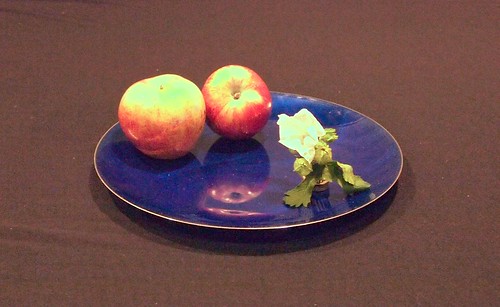
Morimono, minimalist "platter design" Sogetsu 1960s style.
Apples and Malva flower.
In the Sogetsu School, morimono, along with uki-bana (fleeting arrangement) and shiki-bana (arrangement placed directly on a table or a surface without dai or container) belongs to variation no. 7. The three styles in this group have in common that the composition is about arranging positions and combinations of materials to bring out their unique qualities.
The name morimono is a compound word that comes from moru "to heap up" and mono "thing", it's literally translated to "heaped up things" (cf. moribana "heaped up flowers" - morimono is an extension of moribana). The style ranges from simplicity and melancholy of fall with a sense of wabi-sabi, to the joy and abundance of harvest. Morimono can also be made with figures or other things, stone, leaves, roots, etc.
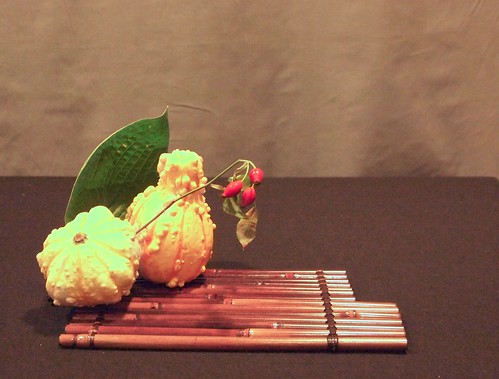
Morimono with the shin element enhanced by a leaf.
Gourds, rose hip and hosta leaf.
Although morimono is a basic style arrangement it doesn't always make sense to start with the correct length of the materials. Instead one must translate the main branches, shin, soe and hikae, to form and volume. You arrange the materials so that the arrangement is recognizable as a basic style or one of the variations of them.
Morimono is usually arranged on a dai. It can be anything that fits, such as a board, a plate, a straw mat, a low basket or a large leaf. The color of dai is important. It often works nice when the dai reinforces colours from the materials either by matching them or by contrasting. Morimono can also be arranged as nageire in a tall vase.
Morimono is usually arranged on a dai. It can be anything that fits, such as a board, a plate, a straw mat, a low basket or a large leaf. The color of dai is important. It often works nice when the dai reinforces colours from the materials either by matching them or by contrasting. Morimono can also be arranged as nageire in a tall vase.
Morimono, nageire.
Mais, gourd, raddishes, Bergenia leaves.
Mais, gourd, raddishes, Bergenia leaves.
Freestyle moribana. Straight and curved lines.
Parsley roots, Dahlia.
Parsley roots, Dahlia.
As with all the basic styles, there is also a free style extension of morimono. In the free style the focus is on creating a more playful sculptural arrangement.
Freestyle nageire. Curved lines.
Chives, red cabbage, mini pear, Creepers, bleached hemp.
Chives, red cabbage, mini pear, Creepers, bleached hemp.
(Sorry about the bad photo quality in this blog post. I recognized too late that the camera settings where incorrect.)
↧
↧
Yuji Ueno - Hanaike
 Yuji Ueno, a former Sogetsu artist now working on his own, has developed a flower concept that he calls Hanaike. He works with live performances creating poetic simplified arrangements with very little plant materials. Note that the to words hana and ike are the same as in ikebana, just in reversed order.
Yuji Ueno, a former Sogetsu artist now working on his own, has developed a flower concept that he calls Hanaike. He works with live performances creating poetic simplified arrangements with very little plant materials. Note that the to words hana and ike are the same as in ikebana, just in reversed order.Recently Yuji Ueno has also been involved in "marginal art" events in the Echigo-Tsumari region, creating new artworks on his expeditions and encounters with local villagers.
Have a look at his inspiring work on this video from Panorama:
↧
Embracing Change
Moribana. Basic slanting reversed style.
Autumn branches and roses.
Autumn branches and roses.
This weeks lesson for my ikebana students was reversed arrangements and autumn in ikebana. Everyone could choose if they wanted to make a basic upright or slanting arrangement in reversed style to express an autumn theme. I found some roses in the garbage after they had gone, and made a basic slanting reversed style myself when I got home.
The change of seasons reminds us that life is constantly changing. These branches have shifted colour from mainly green to almost totally yellow and red since I made this ikebana arrangement. Bringing autumn branches into the home helps grasping the moment of here and now. Enjoy it while it lasts - the next time you look it will already have changed a bit.
The change of seasons reminds us that life is constantly changing. These branches have shifted colour from mainly green to almost totally yellow and red since I made this ikebana arrangement. Bringing autumn branches into the home helps grasping the moment of here and now. Enjoy it while it lasts - the next time you look it will already have changed a bit.
↧
Yuji Ueno - Rolling Flowers Surprise
Now, this is a surprise! Take a look at this video and be prepared to be both touched and amused by a totally different approach to ikebana. Yuji Ueno gives a live performance, Rolling flowers, at a flower event in the mall of Yokohama Landmark Tower in 2011.
More on Yuji Ueno in this blog post.
More on Yuji Ueno in this blog post.
↧
Rikka Inspiration
Ikebana inspired by Rikka, slanting style.
Rikka is the oldest and most complex of all ikebana styles. The Ikenobo school calls it the origin of ikebana. Today the traditional Rikka Shofutai style has also got a more modern sibling; Rikka Shimputai. It's probably fair to say that every ikebana style that exists can be traced back to Rikka in one way or another. In the Sogetsu school we don't really study Rikka or other classical ikebana styles. But it's part of the general ikebana understanding to try and grasp the main rules and the idea of them. That's what makes it so interesting and stimulating to learn a bit more.
I don't aspire to have anything to teach about arranging Rikka. Still I wanted to post this two attempts to mimic the movements of modern Rikka. The upper one is inspired by the slanting style, and is my second try at arranging Rikka. The photo below is my first, much more fumbling attempt inspired by the upright style. One thing I've learned is that it takes a lot of practice and technique to get all the branches wright. I know these are no way near proper Rikka arrangements.
Next I'm going to try a style showing off the water surface, so stay tuned.
I don't aspire to have anything to teach about arranging Rikka. Still I wanted to post this two attempts to mimic the movements of modern Rikka. The upper one is inspired by the slanting style, and is my second try at arranging Rikka. The photo below is my first, much more fumbling attempt inspired by the upright style. One thing I've learned is that it takes a lot of practice and technique to get all the branches wright. I know these are no way near proper Rikka arrangements.
Next I'm going to try a style showing off the water surface, so stay tuned.
↧
↧
Autumn Breeze
↧
Triadic Tertiary Colours
Colour study - blue-green, yellow-orange and red-violet.
Raku vase, Maple leaves, paper stripes, skeleton leaf.
This weekend I attended a workshop arranged by Ikebana International Oslo Chapter with Mit Ingelaere-Brandt from Belgium. She taught us how effective use of colours can change an ikebana arrangement and ad the extra quality that makes it stand out.
Mit Ingelaere-Brandt is well known for editing a series of very popular photo books published by Stichting Kunstboek, with contemporary ikebana from artists around the world. Three books have been published and a fourth is on it's way.
Raku vase, Maple leaves, paper stripes, skeleton leaf.
This weekend I attended a workshop arranged by Ikebana International Oslo Chapter with Mit Ingelaere-Brandt from Belgium. She taught us how effective use of colours can change an ikebana arrangement and ad the extra quality that makes it stand out.
In this arrangement I've used a triadic colour scheme with tertiary colours, a blue-green vase, a mass of yellow-orange leaves and red-violet paper stripes and skeleton leaf. Try to envision what it would look like without the red-violet, and you will get the point. A triadic colour scheme uses colours that are evenly spaced around the colour wheel, and gives a quite vibrant result.
Mit Ingelaere-Brandt is well known for editing a series of very popular photo books published by Stichting Kunstboek, with contemporary ikebana from artists around the world. Three books have been published and a fourth is on it's way.
↧
Split Complementary Paper Wrap
Colour study - red-orange, blue and green.
Japanese paper, blueberry tree bark, Gerbera, pine.
I will continue to post arrangements from the workshop with Mit Ingelaere-Brandt that I attended last weekend. In arrangement number two the task of creating a form of paper and bark is combined with a colour exercise. I decided to use a split-complementary colour scheme for this arrangement. Blueberry tree bark and Gerbera forms a red-orange base, that is contrasted by blue Japanese paper and green pine branches. The split-complementary colour scheme has the same strong visual contrast as the complementary colour scheme, but has less tension. In addition to the base color, it uses the two colors adjacent to its complement.
Japanese paper, blueberry tree bark, Gerbera, pine.
I will continue to post arrangements from the workshop with Mit Ingelaere-Brandt that I attended last weekend. In arrangement number two the task of creating a form of paper and bark is combined with a colour exercise. I decided to use a split-complementary colour scheme for this arrangement. Blueberry tree bark and Gerbera forms a red-orange base, that is contrasted by blue Japanese paper and green pine branches. The split-complementary colour scheme has the same strong visual contrast as the complementary colour scheme, but has less tension. In addition to the base color, it uses the two colors adjacent to its complement.
Blue is a primary colour, while green is a secondary and red-orange a tertiary colour. The complementary colour of red-orange would be blue-green, so the split complementary colours (on each side of the complementary) are blue and green.
↧
Abstract Expression
Abstract composition.
Equisetum, Japanese paper, Chrysanthemum, bleached sisal.
This arrangement is about creating an abstract composition with plant materials and paper. The idea is to use the shape and colour of the materials in a way that doesn't immediately make you think about this or that plant, but rather the sculptural quality of the arrangement.
There are many influences in contemporary ikebana from modern Western art. This arrangement has references to the abstract expressionist movement and the American painter Jackson Pollock.
The equisetum is the dominant material, followed by the paper and the Chrysanthemum. It's easy to see the basic ikebana principles of heaven, human and earth in this composition, if you translate the principles into the amount of materials used and the dominance of shapes and colours.
Equisetum, Japanese paper, Chrysanthemum, bleached sisal.
This arrangement is about creating an abstract composition with plant materials and paper. The idea is to use the shape and colour of the materials in a way that doesn't immediately make you think about this or that plant, but rather the sculptural quality of the arrangement.
There are many influences in contemporary ikebana from modern Western art. This arrangement has references to the abstract expressionist movement and the American painter Jackson Pollock.
The equisetum is the dominant material, followed by the paper and the Chrysanthemum. It's easy to see the basic ikebana principles of heaven, human and earth in this composition, if you translate the principles into the amount of materials used and the dominance of shapes and colours.
Blue Poles, painting by Jackson Pollock, 1952.
The colous sheme is Almost a split-complementary colour scheme with green, yellow and a purple that ideally could have been a bit more purple-red. In this case I found that a yellow and purple made a better contrast.
The colous sheme is Almost a split-complementary colour scheme with green, yellow and a purple that ideally could have been a bit more purple-red. In this case I found that a yellow and purple made a better contrast.
↧
↧
Organic Abstraction - Rectangle Colours
Abstract composition.
Aspidistra, Japanese paper, gourd, bamboo stick.
Aspidistra, Japanese paper, gourd, bamboo stick.
This will be the last blog post from the workshop in Oslo with Mit Ingelaere-Brandt. In this arrangement using curved Aspidistra leaves wrapped around a cylinder vase, a more organic abstract form is demonstrated. The biomorph or organic abstraction movement is probably best known from the sculptures by Henry Moore. Japanese American artist Isamu Noguchi is also a strong exponent for this style.
The leaves are the dominant material in this work, followed by the blue paper and the orange gourd in a 7-5-3 relation.
The tetradic or rectangle colour scheme uses four colors arranged into two complementary pairs, in this case blue and orange, and green and red. Tetradic color schemes works best if you let one color be dominant.
The leaves are the dominant material in this work, followed by the blue paper and the orange gourd in a 7-5-3 relation.
The tetradic or rectangle colour scheme uses four colors arranged into two complementary pairs, in this case blue and orange, and green and red. Tetradic color schemes works best if you let one color be dominant.
Rainbow Lorikeet
↧
More Rikka Inspiration
Rikka inspired arrangement, Suna-no-mono style with two groups.
Here comes another Rikka inspired arrangement (Klick here for an earlier blog post in this series). I'd like to point out again very clearly that I don't aspire to create genuine Rikka arrangements, that's why I call them Rikka inspired. This is not out of disrespect for the traditional styles, but rather an attempt to gain a brief understanding of the old principles that are still important in all ikebana styles.
This time I've been looking into the Suna-no-mono style with two groups, Futakabu-ike. I've used Rowan branches, a Gerbera, three kinds of Chrysanthemum, Aspidistra leaves and Cornus branches with autumn leaves.
Suna-no-mono, translates to "sand and things". The style with two separate groups represents two countryside islands surrounded by the sea. This old historical style is the origin of variation no 5 in the Sogetsu school curriculum, Kabu-wake, arrangement in two groups with water in-between.
If you want to know more about the Rikka style, there is a short introduction of it's origin and develop on the website of Ikenobo headquarters in Kyoto.
This time I've been looking into the Suna-no-mono style with two groups, Futakabu-ike. I've used Rowan branches, a Gerbera, three kinds of Chrysanthemum, Aspidistra leaves and Cornus branches with autumn leaves.
Suna-no-mono, translates to "sand and things". The style with two separate groups represents two countryside islands surrounded by the sea. This old historical style is the origin of variation no 5 in the Sogetsu school curriculum, Kabu-wake, arrangement in two groups with water in-between.
If you want to know more about the Rikka style, there is a short introduction of it's origin and develop on the website of Ikenobo headquarters in Kyoto.
↧
Serene Colours
Serene colours.
Equisetum, Chrystanthemum and Gerbera.
This arrangement, in a large moribana container, consists of three groups of flowers in the colour range of yellow to orange, and a green structure of bent Equisetum with wire in it. The materials are leftover flowers that have been around for a bit more than a week now.
German born American artist Josef Albers is known for his square paintings and optical experiments. He also worked theoretically with colours and further developed the theories by his teacher Johannes Itten at the Weimar Bauhaus. Amongst other things he worked on expressive colour combinations, based on the colour star of Goethe and the coulor triangle. By grouping the colours of the triangle in colour chords he developed a system based on their expressive qualities. My leftover ikebana is based on the Serene colour chord - green, yellow, orange and yellow-orange.
Equisetum, Chrystanthemum and Gerbera.
This arrangement, in a large moribana container, consists of three groups of flowers in the colour range of yellow to orange, and a green structure of bent Equisetum with wire in it. The materials are leftover flowers that have been around for a bit more than a week now.
German born American artist Josef Albers is known for his square paintings and optical experiments. He also worked theoretically with colours and further developed the theories by his teacher Johannes Itten at the Weimar Bauhaus. Amongst other things he worked on expressive colour combinations, based on the colour star of Goethe and the coulor triangle. By grouping the colours of the triangle in colour chords he developed a system based on their expressive qualities. My leftover ikebana is based on the Serene colour chord - green, yellow, orange and yellow-orange.
↧
An Exercise in Humility
Variation no 2 upright. Rose hip and roses.
This weeks lesson at ikebana class was Variation no 2 upright style. In this variation humanity is placed lower than both heaven and earth.
Stella Coe interprets this as a representation of the humility of man before the wonders of heaven and earth.
You can find her interpretations of the basic Sogetsu styles in her book A practical and philosophical guide to Japanese flower arrangement, an ikebana classic that lives up to it's title and shares both practical and philosophical insights.
This weeks lesson at ikebana class was Variation no 2 upright style. In this variation humanity is placed lower than both heaven and earth.
Stella Coe interprets this as a representation of the humility of man before the wonders of heaven and earth.
You can find her interpretations of the basic Sogetsu styles in her book A practical and philosophical guide to Japanese flower arrangement, an ikebana classic that lives up to it's title and shares both practical and philosophical insights.
↧
↧
Abstract Cala Lily - Mass and Lines
Flowers only, straight and curved lines, mass and line.
Ishu-ike, abstract freestyle, moribana.
Ishu-ike, abstract freestyle, moribana.
I found these magnificent Cala lilies at the market square today. They were exactly what I needed. Nice fall colours and long, ferm stems - perfect fore the challenge I got for this weeks class at my ikebana teacher: To make a variety of mass and line designs using the same material.
![]()
Flowers only, straight lines, mass and line.
Ishu-ike, abstract freestyle, moribana.
![]()
Flowers only, straight and curved lines, mass and line.
Ishu-ike, abstract freestyle, moribana.

Flowers only, straight lines, mass and line.
Ishu-ike, abstract freestyle, moribana.
Mass and lines are two of the fundamental elements in ikebana. By showing different kinds of lines, basically straight and curved, in contrast with massed materials a peaceful balance is achieved.
In the teachings of the Sogetsu School it is usually said that the third fundamental element is colour. Christopher James, a friend of mine who is teaching ikebana in Melbourne, argues that it makes even more sense to exchange colour with space when it comes to the essentials of ikebana. The importance of space in Ikebana is, according to him, growing from the early Buddhist tradition of the triptychs, with the middle screen always depicting a “sacred” empty space. So, space has a traditional cultural connection to spirituality in Japan and is extremely important in ikebana. Maybe even to the extent that we should say "mass, line and space" rather than "mass, line and colour".
I find it to be an interesting observation that points out an important thing to keep in mind. When you think about it, the arrangements in this blog post are actually even more about the open space created between the lines, than the actual lines.
In the teachings of the Sogetsu School it is usually said that the third fundamental element is colour. Christopher James, a friend of mine who is teaching ikebana in Melbourne, argues that it makes even more sense to exchange colour with space when it comes to the essentials of ikebana. The importance of space in Ikebana is, according to him, growing from the early Buddhist tradition of the triptychs, with the middle screen always depicting a “sacred” empty space. So, space has a traditional cultural connection to spirituality in Japan and is extremely important in ikebana. Maybe even to the extent that we should say "mass, line and space" rather than "mass, line and colour".
I find it to be an interesting observation that points out an important thing to keep in mind. When you think about it, the arrangements in this blog post are actually even more about the open space created between the lines, than the actual lines.
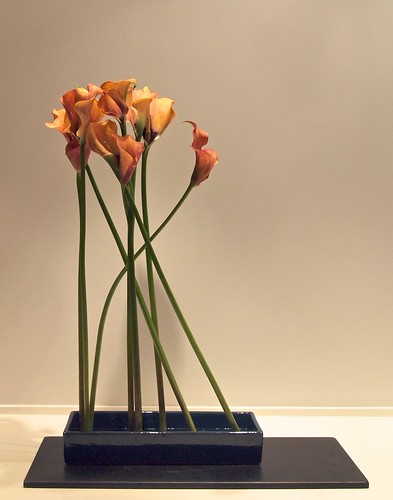
Flowers only, straight and curved lines, mass and line.
Ishu-ike, abstract freestyle, moribana.
The exercise of this blog post exemplifies in a good way that all parts of the plant is equally important in ikebana designs. It's not all about the flower part. In these arrangements the shapes of the stems are the main feature.
A couple of the stems had double sets of petals (I've never seen that before on a Cala), which helped a lot when it came to fixing the flowers against each other.
A couple of the stems had double sets of petals (I've never seen that before on a Cala), which helped a lot when it came to fixing the flowers against each other.
Flowers only, straight lines.
Ishu-ike, abstract freestyle, moribana.
Ishu-ike, abstract freestyle, moribana.
↧
More Cala - Curved and Intertwined
Flowers only, Curved lines, two containers
Ishu-ike, freestyle, moribana.
Ishu-ike, freestyle, moribana.
This blog post contains a few more Cala designs using the stems to create lines. The idea here is to connect two containers with curved and intertwined lines.
![]()
Flowers only, intertwining, two containers, curved lines.
Ishu-ike, abstract freestyle, moribana.
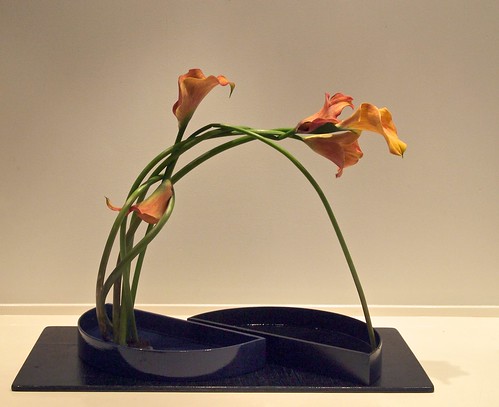
Flowers only, intertwining, two containers, curved lines.
Ishu-ike, abstract freestyle, moribana.
The stems were a bit too fresh for intertwining exercises. They get more flexible when they've been sitting around for a while. Even so, both my teacher and I were satisfied with the result. It was a good exercise to create as many different arrangements as possible with the same material.
Klick here if you want to see more Cala designs and read the first blog post in this short series.
Klick here if you want to see more Cala designs and read the first blog post in this short series.
↧
First Freestyle
The theme of last weeks ikebana class was sketching and creating a freestyle arrangement. The materials were limited to three straws, two leaves and two flowers. Using a limited amount of materials makes it easier not to crowd the arrangement, but keep the lines clear and work on the open spaces in the arrangement. Using two container also help to incorporate space in the work.
This was my beginners class' first attempt with freestyle ikebana. I think they all made a good job keeping in mind the principles we've been working with in the more fixed basic styles, and applying them in a creative encounter with the materials.
If you're in the Oslo area and would like to try ikebana, feel free to contact me as I am currently planning for a new beginners class to start early next year.
If you're in the Oslo area and would like to try ikebana, feel free to contact me as I am currently planning for a new beginners class to start early next year.
↧

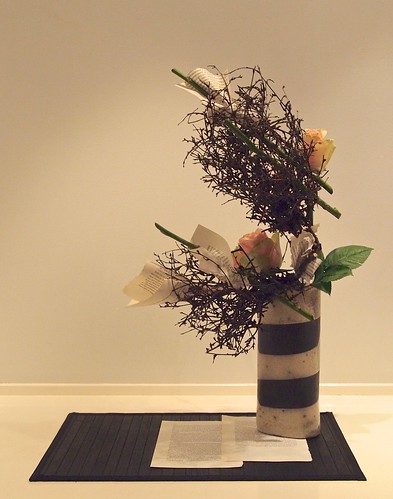

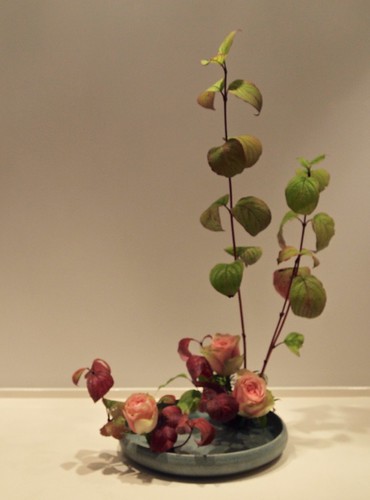




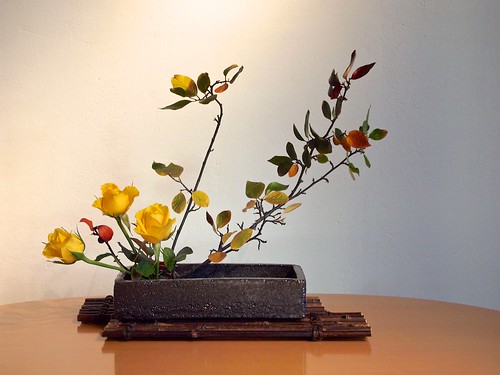
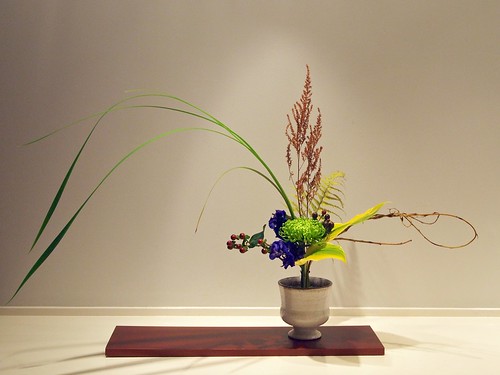

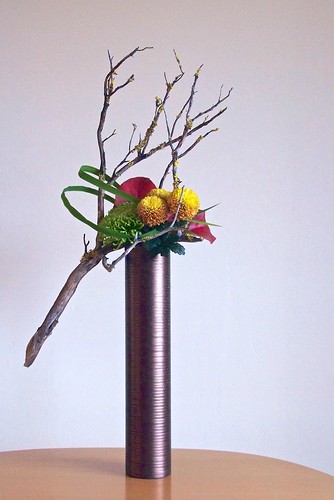
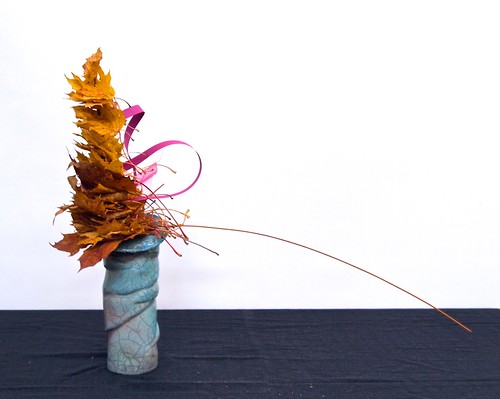
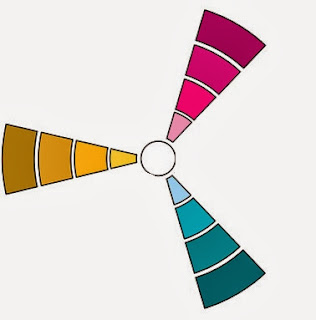
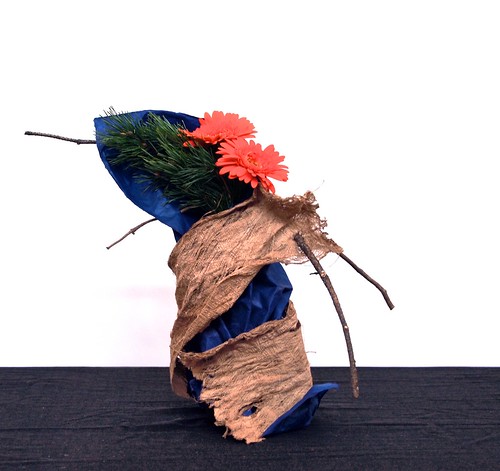


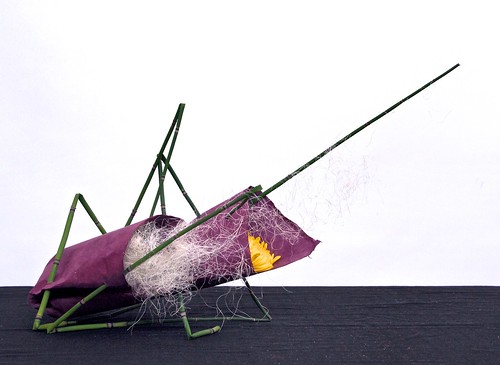
.jpg)
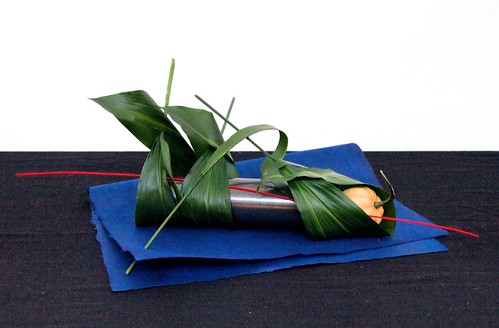


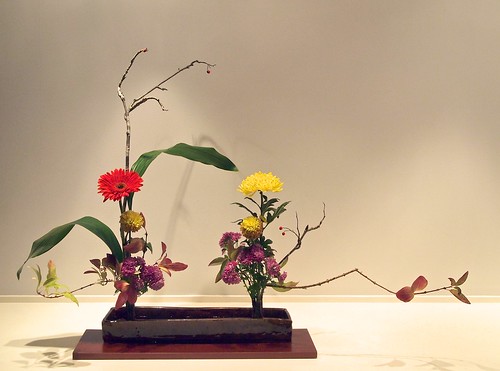

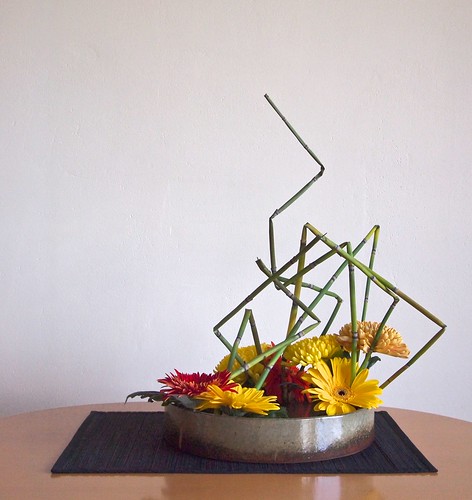

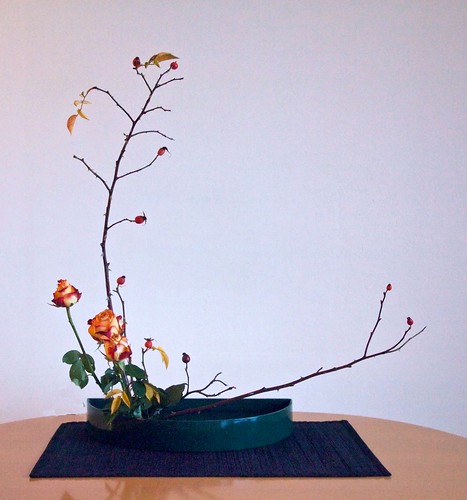

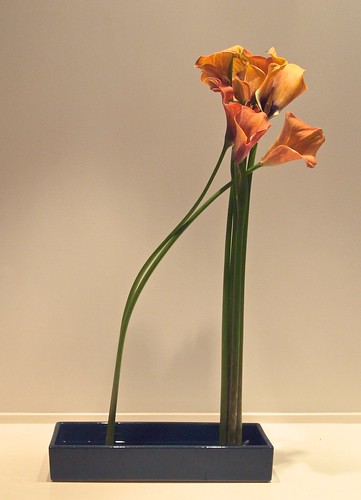
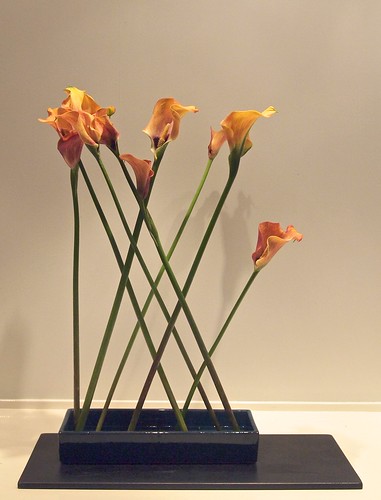



.jpg)